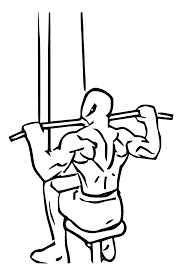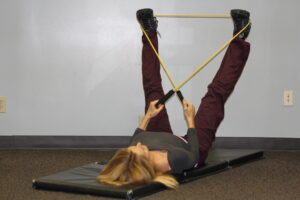For any fitness enthusiast or amateur bodybuilder, the quest for the perfect physique often leads to a focus on key muscle groups, such as the biceps and back. These two muscle sets, not only aesthetically pleasing when well-developed, are also integral to a balanced physique and overall musculoskeletal health. In this comprehensive guide of “Bicep and Back Exercises,” we will walk you through the best exercises, workout plans, tips, and more to help you bulk up your biceps and build a strong, sculpted back.
The Importance of Bicep and Back Exercises in Your Workout Regimen
Before we jump into the top exercises, it’s crucial to understand why focusing on your biceps and back is so vital. The muscles in your back are the foundation for much of your upper body strength and stability. A strong back can enhance posture, prevent injuries, and provide the base for developing other upper body muscles. Meanwhile, the biceps are part of the coveted “show muscles” on the front of the arms. They play a significant role in pulling movements and contribute to everyday functional fitness activities. Below, we detail the benefits each muscle group offers, emphasizing their importance beyond mere aesthetics.
Foundation for Upper Body Strength: The Role of Back Muscles
Your back muscles are at the heart of upper body strength, acting as a pivotal foundation for stability and muscle development. A robust back not only supports better posture but also shields you from potential injuries. This muscular framework is crucial for expanding your strength in other areas, offering a solid base to build upon.
Functional Strength and Daily Performance Enhancement
Targeting the biceps and back doesn’t merely increase muscle mass; it significantly boosts your functional strength. This kind of strength is vital for the execution of natural, everyday movements, enhancing your ability to perform lifting, pulling, and various activities with greater ease and efficiency. Strengthening these muscles can also alleviate pain and discomfort caused by poor posture or sedentary lifestyles, resulting in improved overall daily performance.
Aesthetics: The “Show Muscles” Factor
While a strong back and biceps are more than just about looks, there’s no denying the visual appeal they offer. A well-developed upper body with defined bicep and back muscles can be a source of pride for many individuals, boosting self-confidence and promoting a positive body image.
Best Bicep Exercises to Build Bicep Muscle
Achieving muscular biceps is a goal that combines both strength and aesthetic objectives. The exercises listed below have been carefully selected and expanded upon to maximize your bicep growth, focusing on a blend of compound movements and isolated exercises. Each one has been designed to target the biceps from various angles and intensities, promoting full muscle development. For ease of learning, each exercise includes youtube video demonstration that I have found easy to understand. This will ensure that you can master the correct form for maximum effectiveness.
Advanced Barbell Bicep Curls
Taking the classic Barbell Bicep Curl to the next level involves focusing on the precision of the movement. Ensure that your grip is shoulder-width apart, and your feet are firmly planted. To maximize growth, introduce a tempo change by slowing down the descent of the barbell. This modification increases time under tension, a crucial factor for muscle building.
Incline Dumbbell Hammer Curls
Elevate the standard Hammer Curl by performing it on an incline bench. Set the bench to a 45-degree angle and lie back with dumbbells in each hand. Maintaining a neutral grip, perform the curl. The incline position increases the range of motion and stretches the biceps at the bottom of the movement, inducing greater muscle growth.
Eccentric-Focused Supinated Grip Chin-Ups
Refine the Supinated Grip Chin-Up by concentrating on the eccentric, or lowering, phase. After pulling yourself up, lower back down to a count of three to five seconds. This exercise emphasizes the lengthening of the bicep muscle under load, particularly effective for muscle hypertrophy. It’s a potent exercise that targets the biceps and significantly engages the muscles of the back.
Alternating Dumbbell Bicep Curls with Twist
Enhance the classic Dumbbell Bicep Curl by adding a twist at the top of the movement. Start with palms facing your torso and, as you curl the dumbbell, rotate your wrist so that your palm faces your shoulder at the top. This twist engages more muscle fibers and stimulates additional growth in the biceps.
Isolated Single-Arm Preacher Curls
For focused growth, the Single-Arm Preacher Curl is unparalleled. Using a preacher bench, isolate each arm to target the biceps individually, eliminating the possibility of compensating with the stronger arm. Focus on a full range of motion and control both the lifting and lowering phases for ultimate muscle engagement. This exercise is specifically beneficial for highlighting the peak of the biceps and ensuring balanced development.
By incorporating these comprehensive exercises into your bicep workout, you are guaranteed to notice significant improvements in both the size and strength of your biceps. Each exercise, with its focus on form, tempo, and specific muscle engagement, is catered to stimulate bicep growth efficiently and effectively.
Best Back Exercises to Build Back Muscle
The pursuit of a stronger back is indispensable for aesthetic appeal, improved functional strength, and enhanced daily performance. The following exercises are meticulously chosen to target essential back muscles. Incorporation of these exercises into your routine can significantly contribute to a broad, powerful, and resilient back. Further detail is provided to deepen understanding and execution efficacy.
Deadlifts: The Foundation of Back Strength
Deadlifts are a powerhouse exercise, engaging not only your entire back but also activating the gluteus and hamstring muscles. This compound movement is critical for developing a strong, muscular back. Proper form is crucial – begin with your feet shoulder-width apart, grip the barbell outside your legs, and keep your back straight as you lift, using your legs and hips to drive the movement. It builds mass and strengthens the lower back, traps, and even forearms, making it a staple in any back-strengthening regimen. I am including youtube video demonstration here also for you to understand these back exercises.
Pull-Ups: Sculpting the Upper Back
Pull-Ups are unparalleled in their ability to sculpt the upper back, specifically the latissimus dorsi muscles, which are crucial for that coveted V-shaped torso. This exercise requires a strong grip and focuses on lifting your body weight by pulling yourself up until your chin is above the bar and then lowering yourself back down with control. Variations in grip width can target different areas of the back for balanced strength and definition.
Bent-over Row: The Versatile Back Builder
The Bent-over Row is an essential exercise for building a strong and defined back. It can be performed with either a barbell or dumbbells, targeting the entire back muscle group, including the lats, traps, rhomboids, and rear deltoids. Maintaining proper form is crucial – hinge at the hips with a slight bend in your knees, keeping your
Pendlay Row: Precision and Power
The Pendlay row, named after weightlifting coach Glenn Pendlay, emphasizes explosive power from a horizontal position. This variation requires the bar to start on the ground for each rep, effectively eliminating momentum and ensuring that the upper back and lats are engaged fully with each lift. It’s an excellent exercise for enhancing upper back strength and size, demanding precision and control in execution.
Dumbbell Pullover: Expanding the Back
The dumbbell pullover is a unique exercise that not only targets the latissimus dorsi but also stretches and works the chest and the serratus anterior muscles along the ribcage. This dual-action exercise is performed by lying on a bench, holding a dumbbell with both hands extended above the chest, and then slowly lowering it behind your head before bringing it back to the starting position. It’s particularly effective for expanding the rib cage and creating a wider back.
Incorporating these exercises into your workout routine can yield significant improvements in back strength, aesthetics, and overall performance. Remember, variation and consistency are key to achieving the best results.
Workout Tips for Bigger Biceps and Back
In the quest for muscular biceps and a broad, powerful back, tailoring your workout regimen with strategic approaches is paramount. Below are refined strategies that, when implemented, can dramatically improve your gains.
Effective Workout Routines
For a well-rounded approach to muscle building, your workout routine should involve a variety of exercises to stimulate the muscles in different ways. Incorporating a mix of compound and isolation exercises helps ensure comprehensive muscle growth.
The Importance of Proper Form
It cannot be overstated how crucial maintaining proper form is during resistance training. Not only does it target the intended muscle effectively, but good form also helps prevent injuries that could derail your training.
Consistency and Progressive Overload
Consistently following your workout routine and gradually increasing the weight or resistance over time is crucial for muscle growth. Progressive overload challenges your muscles, forcing them to adapt and grow stronger. However, it’s essential to increase the intensity gradually to avoid overtraining and injuries.
Recovery and Nutrition: The Unsung Heroes
Muscle growth occurs not only during workouts but also through proper rest and nutrition. Ensuring adequate recovery time between workouts for each muscle group and fueling your body with the right nutrients are integral for repairing and building muscle tissue. Incorporate a diet rich in proteins, healthy fats, and carbohydrates, and consider supplements if necessary to support your training goals.
Mind-Muscle Connection
Enhance your workout by focusing on the mind-muscle connection—concentrating on the contraction and movement of the muscle you’re working. This technique can lead to more significant muscle recruitment and, ultimately, more efficient workouts. Visualizing the muscle working and focusing on its contraction can significantly increase the quality of each rep and set.
Evaluation and Adaptation
Regularly evaluate your progress and be willing to adapt your routine. If you find that certain exercises aren’t yielding the expected results or if you hit a plateau, consider altering your routine. Introducing new exercises, changing the order of exercises, or adjusting your rest periods are strategies that can reignite muscle growth.
By integrating these refined workout strategies, you’re setting a solid foundation for achieving substantial biceps and back growth. Remember, the key to success lies in the balance of exercise, nutrition, and rest, combined with a dedication to continuous improvement.
7-Day Bicep and Back Workout Plan

A study in the Journal of Strength and Conditioning Research found that compound exercises like rows and pull-ups engage and strengthen the biceps due to their role in pulling movements.
– Journal of Strength and Conditioning Research, 19(3), 587-591
Tailoring an effective workout strategy for biceps and back requires careful planning. Here’s a structured 7-day plan dedicated to maximizing growth, strength, and sculpting the upper body with keen attention to detail for each session.
1st Day: Intense Biceps Sculpting
- Barbell Curls: Begin with 4 sets of 10 repetitions, focusing on slow, controlled lifts to fully engage the bicep muscles.
- Hammer Curls: Continue the bicep bombardment with 3 sets of 12 reps, alternating arms to maintain balance and symmetry.
- Concentration Curls: Wrap up with 3 sets of 15 reps; perform these seated with elbow against knee for isolated muscle work.
2nd Day: Comprehensive Back Strengthening
- Deadlifts: Execute 4 sets of 8 reps, ensuring correct form to engage the lower back, glutes, and hamstrings.
- Pull-Ups: Do 3 sets until failure, using a wide grip to maximize lat engagement and enhance the back’s V-shape.
- Seated Rows: Finish with 3 sets of 12 reps, pulling towards the lower abdomen to target the mid-to-lower back muscles precisely.
3rd Day: Mandatory Rest
Take this day to rest, focusing on muscle recovery with adequate protein intake and hydration. Muscle growth occurs during rest, making this day as crucial as training days.
4th Day: Dynamic Biceps Building
- Bicep Curls (with resistance bands): Perform 4 sets of 12 reps, utilizing the constant tension of bands to challenge the biceps differently.
- Chin-Ups: Approach with 3 sets until failure, using a closer grip to place more emphasis on the biceps.
- Hammer Curls: Execute 3 sets of 15 reps for a final push on bicep thickness and forearm strength.
5th Day: Targeted Back Development
- Pendlay Rows: Conduct 4 sets of 10 reps, focusing on explosiveness and full muscle engagement from a dead stop.
- Lat Pull-Downs: Proceed with 4 sets of 12 reps, opting for a slight lean back to enhance lat width.
- Dumbbell Pullovers: Conclude with 3 sets of 15 reps, stretching and working the lats, chest, and serratus anterior for a comprehensive upper-body workout.
6th Day: Rest and Repair
Again, rest is paramount; use this day for muscle recovery. Consider light stretching or a mild walk to promote blood circulation without overstressing muscles.
7th Day: Peak Biceps Intensification
- Barbell Curls: Attack the biceps with 4 sets of 12 reps, emphasizing form and full range of motion.
- Hammer Curls: Follow up with 3 sets of 15 reps, maintaining focus on the brachialis and biceps.
- Concentration Curls: End the cycle with 3 sets to failure, ensuring each set pushes the biceps to their limit, promoting growth and endurance.
8th Day: Advanced Back Augmentation
- Deadlifts: Start strong with 4 sets of 6 reps, prioritizing form and power for foundational back strength.
- Pull-Ups: Engage the lats fully with 3 sets to failure, aiming for maximum repetitions.
- Bent-Over Barbell Rows: Finalize the routine with 3 sets of 10 reps, each movement targeting the upper back, reinforcing thickness and muscle density.
This 7-Day Bicep and Back Workout Plan places a laser focus on strategic exercise selection, structured rest, and incremental challenge to ensure continuous progress in both biceps and back development.
Nutrition for Bigger Back and Biceps
Optimal Protein Intake
For muscle growth, particularly in the areas of the back and biceps, consuming high-quality protein is essential. Aim for lean sources like chicken breast, fish, tofu, legumes, and eggs. Incorporating a variety of these sources ensures a broad spectrum of amino acids which are crucial for muscle repair and growth. Consider spreading protein intake evenly across your meals to maximize muscle protein synthesis throughout the day.
Hydration is Crucial
Do not underestimate the role of water in your muscle-building quest. Proper hydration aids in nutrient transportation, muscle function, and recovery processes. A general guideline is to consume at least 8-10 glasses of water daily, with additional intake before, during, and after workouts to offset the water lost through perspiration.
The Role of Healthy Fats
Healthy fats, particularly omega-3 fatty acids found in fish, flaxseeds, walnuts, and chia seeds, play a significant role in hormonal balance and inflammation reduction. These benefits contribute to a healthier environment for muscle growth and recovery. Incorporating a moderate amount of healthy fats into your diet can also improve energy levels and satiety between meals.
Carbohydrates for Energy
Carbohydrates are your body’s primary energy source during high-intensity workouts like weightlifting. Including a mix of complex carbohydrates such as whole grains, vegetables, and fruits in your diet can provide sustained energy for longer workout sessions. Additionally, consuming simple carbohydrates immediately post-workout can help replenish muscle glycogen stores, facilitating quicker recovery.
Micronutrients Matter
Vitamins and minerals, while not directly responsible for muscle growth, support body functions that contribute to physical performance and recovery. For instance, magnesium plays a vital role in muscle contraction and relaxation, while vitamin C supports collagen production for joint and tissue health. A varied diet rich in fruits, vegetables, nuts, and seeds can help meet these micronutrient needs.
Timing Your Nutrition
Nutrient timing can enhance workout performance and recovery. Eating a meal rich in proteins and carbohydrates 1-2 hours before a workout can fuel your session. Post-workout, a similar meal can kickstart the recovery process. Consider including a protein shake or a simple carbohydrate snack immediately after your workout if a full meal is not feasible, to aid in quick muscle recovery.
By following these expanded nutrition guidelines, you’re not only fueling your body for better performance and recovery but also supporting overall health, which is crucial for long-term fitness success.
Integrating Bicep and Back Workouts into Your Regular Gym Schedule
Create a Balanced Split Routine
To efficiently incorporate bicep and back exercises into your fitness regimen, design a split routine that targets each muscle group at least twice a week. This strategy ensures that your muscles receive adequate stimulus for growth without the risk of overexertion.
Set Clear Objectives
Align your exercise choices with your specific fitness objectives. For instance, if enhancing your back strength and improving your pull-up performance are your goals, prioritize back-centric exercises on your workout days. Conversely, if developing biceps is your focus, exercises like barbell curls should take precedence in your routine.
Monitor Workout Intensity and Recovery
Keep track of your muscle soreness, the “pump” feeling during workouts, and your strength levels. These indicators will help you adjust the intensity of your workouts and ensure you are effectively targeting the intended muscle groups.
Incorporate Progressive Overload
Gradually increase the weight, volume (number of sets and reps), or intensity of your workouts over time. Progressive overload is crucial for continuous muscle growth and strength gains. Start with lighter weights to master the form and then incrementally add weight to challenge your muscles further.
Schedule Rest and Recovery
Just as important as the workout itself is allowing your muscles time to recover and grow. Ensure you have at least 48 hours of rest between targeting the same muscle groups to prevent overtraining and to facilitate muscle repair and growth.
Utilize Compound and Isolation Exercises
Combine compound movements like deadlifts and pull-ups that work multiple muscle groups with isolation exercises such as bicep curls and concentration curls. This approach ensures a comprehensive workout that enhances overall strength and targets specific muscle groups for growth.
Pay Attention to Technique
Focusing on proper form is critical in maximizing the effectiveness of each exercise and preventing injuries. Take time to learn the correct technique, particularly for complex compound movements, and consider consulting with a trainer if necessary.
Experiment with Different Equipment
Don’t limit your workouts to just barbells and dumbbells. Incorporating a variety of equipment such as resistance bands, cable machines, and kettlebells can add diversity to your routine and challenge your muscles in new ways.
Tailor Your Routine to Your Body’s Response
Everyone’s body reacts differently to various exercises and workout intensities. Pay attention to how your body responds to certain workouts and adjust your routine accordingly. This personalized approach ensures that you are effectively working towards your specific fitness goals.
Engage in Constant Learning
Stay informed about the latest workout trends, techniques, and research in fitness. The field of exercise science is always evolving, and staying updated can provide you with new strategies to enhance your workout effectiveness.
Frequently Asked Questions about Bicep and Back Workouts
Should I Do Both Biceps and Back in the Same Workout?
While it’s possible to combine both muscle groups in a single workout, especially for beginners, splitting them into separate workouts can allow for more focused training and better recovery for each muscle group.
How Many Reps and Sets Should I Do for Best Results?
A general guideline is 3-5 sets of 6-12 repetitions for most exercises. Adjust based on your experience level and personal goals.
Can I Substitute Machines for Free Weights in My Workouts?
Both free weights and machines have their place in a training regimen. Free weights tend to offer a more natural range of motion and engage stabilizing muscles, while machines can help isolate targeted muscles.
How Often Should I Increase the Weights I’m Lifting?
It’s recommended to assess your strength and performance every 2-4 weeks. If your current sets become significantly easier, consider increasing the weights. The increment should challenge you but still allow you to maintain proper form.
Is It Necessary to Take Supplements for Muscle Growth?
While supplements can aid in muscle growth and recovery, they should not replace a balanced diet. Proper nutrition from whole foods is sufficient for most individuals. Supplements like protein powders can be beneficial if you struggle to meet your protein needs through diet alone.
What Are the Signs of Overtraining?
Symptoms of overtraining include prolonged muscle soreness, fatigue, decreased performance, sleep disturbances, and a general feeling of burnout. Listening to your body and ensuring adequate rest and recovery can help prevent overtraining.
How Important Is Sleep in Muscle Recovery?
Sleep is critical for muscle recovery and growth. During sleep, your body produces growth hormone and repairs muscle tissue damaged during workouts. Aim for 7-9 hours of quality sleep per night to support overall health and fitness progress.
Can Cardio Exercises Affect Muscle Growth?
While excessive cardio can potentially interfere with muscle growth by burning calories needed for recovery and muscle building, moderate cardio can improve cardiovascular health without significantly impacting muscle gains. Balance is key.
Ready to Flex Those Gains?
Implementing these exercises and workout plans can kickstart your journey to achieving that coveted V-tapered back and bulging biceps. Remember, consistency is key, and progress won’t happen overnight. Focus on proper form, mix up your routines, and fuel your body with the right nutrition. With time and dedication, you’ll be amazed at the transformation you can achieve. Keep pushing, pulling, and lifting your way to success.








